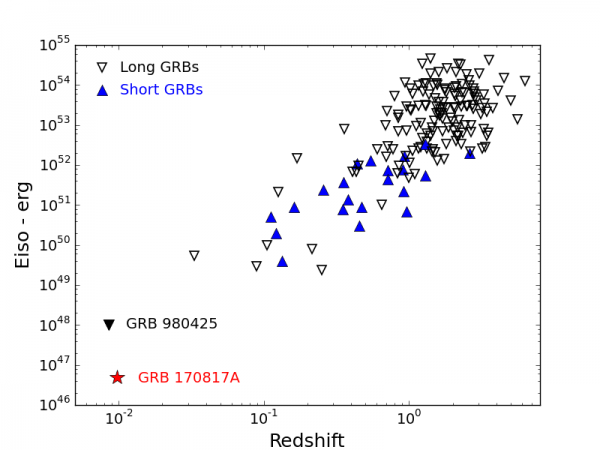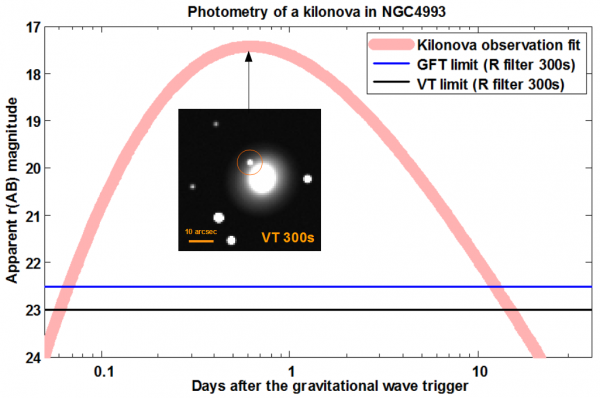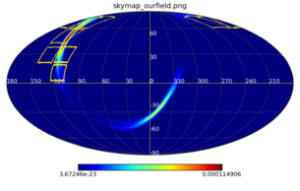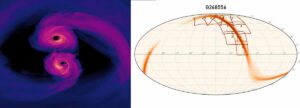The event of August 2017
On August 17, 2017, ground-based gravitational wave detectors (LIGO and Virgo) detected an event, called GW 170817, interpreted as the fusion of two neutron stars. This is the first time that LIGO detects a signal whose profile is similar to the fusion of two neutron stars, but what made the event even more unique is the temporal and spatial coincident detection of a short gamma burst GRB170817A by the GBM detector onboard the Fermi satellite. The detection was confirmed and announced in the following minutes by the SPI spectrometer onboard the INTEGRAL satellite.
The characteristics of GRB170817A were published after a few hours on the site of the Fermi / GBM mission. This is a low-intensity short gamma burst lasting about 2 seconds. Taking into account the distance estimated by the gravitational wave analyses, as well as its observed flux, GRB 170817A is an unusual burst, particularly sub-luminous (see Figure 1). It could be a gamma burst seen from the side.

An unprecedented observational campaign followed, mobilizing dozens of observatories on Earth and in space to detect and characterize the electromagnetic counterpart of the gravitational wave source. Thanks to the contribution of Virgo, the error circle was considerably reduced which allowed a fast tracking on the ground by small telescopes. By selecting galaxies located at the distance deduced from the gravitational signal, the 1 m Swope telescope at the Las Campanas observatory detected a new source SSS17A near the galaxy NGC 4993 at 40 Mpc. In the hours that followed other telescopes (DLT 40, Vista, Master, DECam, LCOGT) confirmed this detection, motivating the whole community to focus on SSS17A and leading to the detection of the electromagnetic counterpart of GW 170817 in all the wavelengths of the ultraviolet to the radio domain. This unprecedented campaign was rewarded by the discovery of a kilonova [1].
The succession of observations that have made the detection and localisation of the electromagnetic counterparts of GW 170817 possible reinforces the observational strategy chosen for the SVOM mission. With its set of interconnected multi-wavelength detectors, covering the electromagnetic spectrum from gamma rays to infra-red, SVOM will be able to detect and study these gravitational wave sources resulting from the fusion of two neutron stars and producing short bursts.
What would have SVOM seen if the mission had been online on the 17th of August 2017 ?
If the burst had appeared in the field of view of its high-energy detectors (ECLAIRs and GRM), SVOM would have detected it with a high probability and would have sent a trigger warning to the ground (see figure 2), all the while measuring the energy emitted in gamma rays. At the same time, the satellite would have slewed automatically to put the burst in the center of the field of view of its X-ray and optical instruments (MXT and VT), initiating an observing sequence of several hours. The optical counterpart of GW 170817, the emission produced by the kilonova associated with the fusion of the two neutron stars, would have been easily detected by the visible telescope VT [2] (see Figure 3).

But what would SVOM have seen if GRB170817A had not been in the field of view of its high-energy instruments (ECLAIRs and GRM) ?
Upon receiving the LIGO-Virgo alert at the French scientific center, SVOM would have triggered its robotic telescopes (F-GFT and C-GFT). By selecting nearby galaxies compatible with the probable distance from the event and contained in the gravitational wave detector error circle, SVOM’s robotic telescopes would have started a systematic search for the optical counterpart by performing several observation cycles. This strategy is particularly suited for the discovery of transient objects in their brightening phase. Thanks to its sensitivity but also thanks to its infra-red capabilities, the French GFT would certainly have detected the kilonova associated with GW 170817 (see figure 3).

In parallel, the French scientific center would have prepared a request for a multi-messenger opportunity target, asking the satellite to interrupt its observing sequence and point at various regions of the sky within the error circle of the gravitational wave detectors. It typically takes about ten hours to reprogram the satellite. Although arriving later, the VT would have easily detected the kilonova associated with the fusion of the two neutron stars (see Figure 3).
And now ?
In the beginning of the next decade, thanks to its ground and space-based instruments, the SVOM mission will certainly be a major player in the study of the transient sky and should significantly contribute to the study of gravitational wave sources. Starting next year, some of the SVOM ground-based telescopes (GWAC) should be operational and should validate the strategies implemented within the consortium at the next LIGO-Virgo data collection scheduled for autumn 2018.
[1] Kilonova: during the coalescence of two neutron stars, neutron-rich material is suddenly released under temperature and density conditions very favorable for the nucleosynthesis of heavy elements by the fast neutron capture process (process r). This is expected to result in the quasi-isotropic ejection of heavy-element-enriched material. This material is heated by the radioactivity of freshly synthesised elements and radiate thermally, with a color evolution from blue to red due to progressive cooling. This emission called kilonova has a physical origin quite distinct from the gamma ray burst and its afterglow.
[2] For this event no short-term X-ray observations occurred. It is therefore difficult to predict a possible detection by the MXT X-ray telescope, despite the fact that it is expected by various models.


